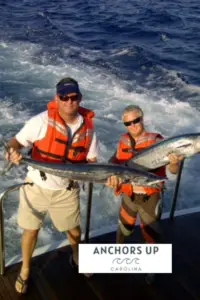One of the most intriguing ways to catch fish is by trolling at high speeds. However, remember that high-speed trolling is only done in the ocean. Without question, many pelagic ocean fish swim at incredibly fast speeds. Therefore, the fish becomes enticed to bite lures imitating baitfish dragged through the water rapidly. I have high speed trolled on multiple occasions and found significant success. Here are the basics of high speed trolling.
What Is Considered High Speed Trolling
The ocean’s blue waters are incredibly clear; therefore, lures, when trolled at high speeds, are easily seen by game fish such as wahoo.
Defining what is considered high speed is keeping the boat in motion with speeds ranging between 12 and 18 knots. Conversely, standard trolling speeds range between 6 and 8 knots. Undoubtedly, weights and heavy lures are required when trolling at high speed versus regular speeds. Without weights, the lures would become airborne consistently and eliminate the chances of being struck by a fish. Specifically, the leads are called cigar weights because of the cigar shape.
As a former 200 ton captain, I have trolled at high speeds from multiple vessels, including center consoles, sportfish boats, and yes even yachts. Amazingly, I have caught numerous wahoo while high speed trolling from a 172 foot Feadship yacht. However, compared to fishing from sportfishing boats or center consoles, the yacht is challenging to slow down. With that being said, the drag runs out at alarming speeds. Therefore, high capacity reels are required.
What Is The Best Depth To Troll For Wahoo
Wahoos are scattered about the ocean from offshore waters and up as shallow as 150 feet. When trolling and high speeds, the best depth to troll for wahoo is 150 feet and out to 500 feet.
Without question, wahoo prefer contour and structure. Countour and structure hold bait because of upwellings or shelter.
Anglers trolling at high speeds must continuously monitor bottom reading equipment and chart plotters. While remaining between 150 and 500 feet, troll over areas where the bottom rapidly changes depth and also over deep water wrecks.
Once you strike in a specific location, continue to work the area as wahoos gather in schools. Lastly, it is not uncommon to have simultaneous hookups.
Is Wahoo Fishing Better Before Or After Full Moon
The moon phase highly impacts the strength of the wahoo bite when trolling at high speeds. Take it from me; I have fished at varying moon phases but can attest to the wahoo bite maxing out just before and just after the full moon.
Tides are impacted by the moon. Full moons create more significant tidal swings, and more considerable tides cause more bait to be sucked from shallow waters on the reefs out to deeper water. For this reason, the wahoo feed aggressively while the food source is available.
When planning to head out trolling, particularly at high speeds, I recommend reviewing the moon phase calendar. Maximize the bite, especially for wahoo venture offshore when the moon is full.
Lastly, one of the best resources for trolling at high speeds for wahoo is the Wahoo Junkies Facebook group. I personally know the owner of the group. Captain Tim Altman is one of the best high speed anglers in the South East. Captain Tim is featured in some of the top fishing publications in the United States.
How Far Behind The Boat Should I High Speed Troll
When it comes to high speeding think distance. Remember, the boat and lures are traveling through the water at a high rate of speed. For this reason, you cannot fish lures short behind the boat because they will skip wildly along the surface.
Without question, the lures must be dragged between 100 and 150 yards behind the vessel. Notably, the lines must be staggered. Troll one rod at 100 yards and the second at 150. The purpose of staggering is to allow for increased maneuverability without becoming tangled. Remember, you will be unable to utilize more than 2 rod and reel combinations.
Interestingly, I came tight on a blue marlin when high speeding through the Bahamas. It is important to be able to clear the second line rapidly when coming tight on a fish. Despite staggering the lines, the fish can quickly entangle the second lure. In the situation of the marlin, the fish was jumping wildly and swimming side to side.
The Basics Of High Speed Trolling Are Important
The concept of trolling at high speeds is daunting to anglers who have never given it a shot. Believe me, it’s straightforward, and the excitement is unmatched when a fish strikes and swims in the opposite direction at such high rates of speed. Lastly, the investment into fishing gear is steep, so be prepared to fork out some money.







